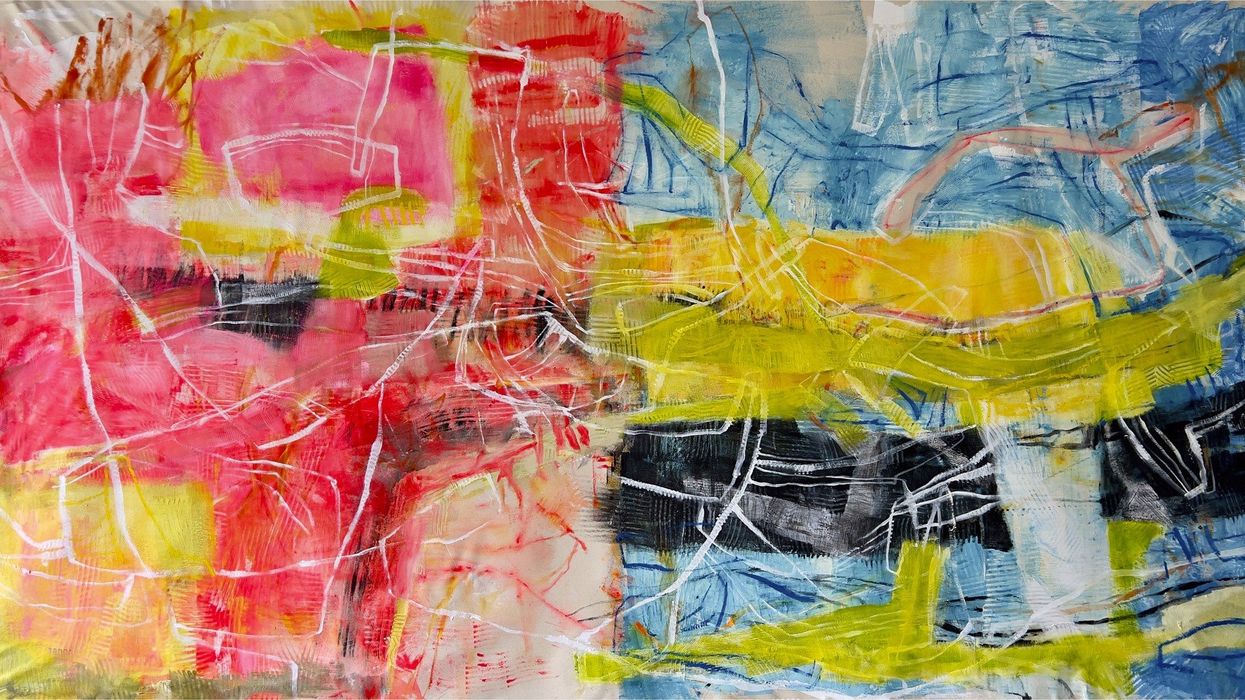Immigrant Artist's Colorful Abstractions Push Viewers to Sit with Discomfort

'Satuaracion Inversa 1' by Tatiana Escallon
CAN ABSTRACT ART be political? Renowned artist Sam Gilliam answered this question in the affirmative. “It messes with you,” said Gilliam of his preferred mode of expression. “It challenges you to understand something that is different.”
Colombia-born artist Tatiana Escallón, who immigrated to the U.S. at age 30, uses the language of abstract art to compel the viewer toward just such an understanding. The title Escallón has chosen for her exhibit, The “I” in Immigration, on view at Anya Tish Gallery July 12-Aug 3, is a bold statement in a world — “a political world,” as Bob Dylan once sang — where the simple acknowledgment our shared humanity, regardless of where a person was born and later on calls home, is seen as suspect. Inspired by the lines, shapes and textures that distinguish historic Spanish colonial architecture, Escallón’s art transforms the concrete into something more fluid and elemental: It evokes memories of her native land, and the strength and resilience one needs to survive and prosper in an unfamiliar and sometimes not-so-friendly landscape.
Many Houston-based artists' work speaks to the pain and joy of the immigrant experience, such as Haitian-born painter, muralist and sculptor Mathieu JN Baptiste, and Bahia-born painter and performance artist Ibraim Nascimento. Their creations are often representational and figurative, with the subjects navigating surreal, sometimes half-erased landscapes, adorned with clothing, masks, and jewelry that connects the old world with the new. Escallón’s approach when exploring similar territory is more elusive and mysterious, even hermetic. In conversation and on social media, she provides plenty of backstory, but when it comes to the work itself, Escallón pushes the viewer to try and determine what they’re seeing and if lost, sit with their feelings of displacement and otherness.

The artist at work

'Shadows in Motion'

'Mapping Me 07'
Escallón is also a poet. Her mixed-media works previously shown at Anya Tish included words and phrases from her fragmented prose, scrawled in both Spanish and English, and nearly illegible beneath layer after layer of acrylic, rubber, oil, spray paint and collage materials. Words are absent from works in The “I” in Immigration, but poetry is present in the way Escallón composes and creates a unified whole with such disparate materials.
In the absence of words, Escallón’s titles are important and offer the harried viewer a way into the origin of these works. “Satuaracion Inversa 1” (“Reverse Saturation”), the title of the largest canvas in the exhibit, may refer to the very techniques Escallón used to create the two sections of this powerful and gorgeous painting. The title is also a wry, poetic definition of the process of transformation she herself experienced as a stranger in a strange land.
In “Shadows in Motion,” old-world architecture has morphed into something unruly and electric, in which crudely drawn patterns of black lines, applied by a small brush at the end of a long pole while standing over the canvas, are squeezed within islands of pink, green, blue, and other colors, creating a bird’s eye view of an urban landscape, as a fistful of dramatic Franz Kline-like brush strokes attempt to hijack the foreground.
True to the concept of a “pop-up” exhibit, The “I” in Immigration, is on view for a limited time — and should be seen more than once with fresh eyes.
- In 2024 ‘Cool 100,’ CityBook Ranks Key Players of the Moment. Did You Make the List? ›
- An Arts Writer Offers a Moving Tribute to the Late Gallerist Anya Tish ›
- Two for the Show: Colors Converge in Joint Exhibit at Anya Tish ›
- Provocative Pop-Up Show Transforms Montrose Gallery for Two Weeks ›
























